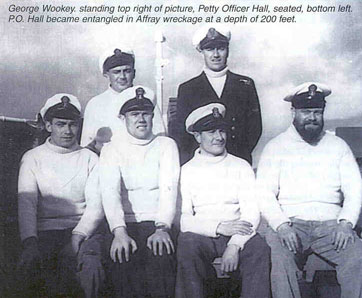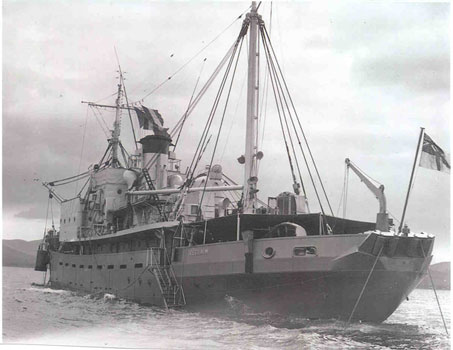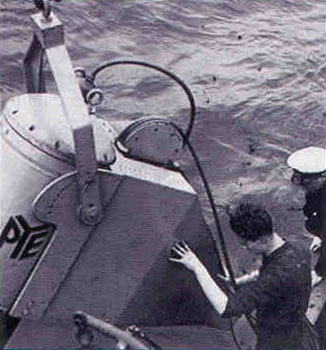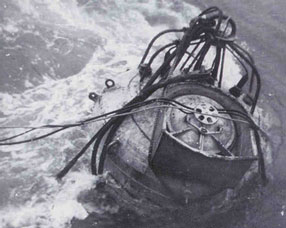
"Subsmash?" "Subsunk!" - The 'Affray' Tragedy.
by George Wookey. Edited by David Strike
On the 16th April, 1951, a British submarine - HMS/M Affray, one of several of her class built during WWII - put to sea in the English Channel on a peaceful, simulated war mission.
Affray's total complement of 75 officers and men included, on this occasion, a class of 23 junior officers undergoing submarine training and a small unit of Royal Marine Commandos.
The sea going orders for Affray were liberal. Her Captain had freedom of movement to land the Commandos - using collapsible canoes - on any part of a stretch of the south-west coast of England on a shore assault exercise.
S/M Affray was one of a class of submarines that had been built with the snorkel device - a pneumatically raised and lowered steel tube which, when in the vertical position allowed passage of air to the engine room permitting the submarine to proceed below the surface at periscope depth.
By this means a submarine need never come right to the surface and reveal her position to an enemy.
It was usual to travel from point A to point B well below periscope depth - the main engines then being powered by the submarine's enormous banks of electric batteries - and only occasionally was there a need to come to periscope depth in order to run on the diesel engines and re-charge the batteries.

The snorkel tube on Affray originally housed both the air intake and battery vents, but a later modification altered this arrangement making both tubes within the snorkel air intakes, while the battery vent was moved to the after end of the upper conning tower.
Hinged to the hull, on the port side of the submarine abreast of the after end of the conning tower, the snorkel lies horizontal when in it's lowered position. At its top end was a float valve that closed automatically if the submarine was taken below its periscope depth while running.
At the point where the air intake entered the actual pressure hull of the submarine there was a bulbous casting - projecting about two feet above the pressure hull - that housed the main induction valve. Manually operated from within the engine room this very important casting was totally concealed and protected by the free flooding deck casing.
Affray left her home base at about 1600 hrs on the 16th April. Normally submarines would make radio contact at set periods - usually 0800 and 2000 - each day, reporting position, course and speed. Her report on the 16th had been made normally and the last contact, about 2100, had included Affray's forecast position at noon on the 17th.
When, on the 17th, Affray failed to make radio contact with the Commander-in-Chief's Southern Command H.Q. an immediate report was made to the Admiralty in London, who at once flashed the Codeword, "SUBSMASH" to the British Fleet and combined NATO navies.
The well established and practiced, R.N./S.M. search and rescue organisation is spread between the naval resources around the British Isles. Included among the vessels was the deep diving and S/M rescue ship, H.M.S. Reclaim - at that time the most up-to date craft of her type in the world.

HMS Reclaim undertaking deep diving trials at Loch Fyne. Note SDC hanging over the ship prior to lowering.
At 24-hours notice for steam, the bulk of Reclaim's crew were on leave, only a nucleus of officers and men remaining on board. Fortunately this included the Engineer, the Medical Officer, both Diving Officers, (one of whom was George Wookey), plus 4 divers and 1 telegraphist.
While the Base Staff ashore undertook the recall of the other officers and crew, those on-board loaded stores and prepared the ship for sea. Within a matter of hours mooring lines were slipped and Reclaim was at sea, quickly followed by other ships in the search organisation.
On average the Subsmash organisation was called into action about once every two years. Seldom had the signal changed to "SUBSUNK", the signal when it is positively known that the submarine has been critically damaged or sunk.
(Usually the signal "Subsurfaced" was received after a few hours - the delay in signal transmission having been caused by some technical difficulty).
No such signal was received from Affray, and as the hours turned into days, with still no indication of Affray's whereabouts, despair settled over the fleet. It was considered that under no circumstances could the crew of a sunken, undamaged submarine survive after a maximum of four or five days.
The search continued for many weeks in what proved to be some of the most unseasonable weather of the year. During this time a total of 13 sonar contacts were made, each thought to be Affray. On each occasion Reclaim would moor over the site while divers descended, only to discover yet another uncharted casualty of World War II.
A near fatality occurred on one of these diving investigations when diver - Petty Officer Hall, became ensnared on tangled wreckage at a depth of 200 ft. His telephone breast rope became trapped and, unable to free himself, Hall was overcome by a rising percentage of carbon-dioxide, resulting in mounting hysteria which could clearly be heard over his intercom. Abruptly his intercom became dead. His breast rope became slack and was quickly pulled to the surface with no diver on its end. Immediate horror turned to relief as Hall surfaced, feet first, down tide about 50-metres from the ship 's side. Quickly hauled back to the diving door by his attendants pulling on his still connected air line, Hall was pulled inboard, thankfully still conscious but very wet and cold. He was quickly rushed to the RCC and subjected to therapeutic decompression, later emerging little the worse for his terrifying ordeal.
Had Hall surfaced in the upright attitude it is likely that he would have drowned from a flooded suit caused by the hole left in his helmet when the breast rope was torn away! The search pattern for Affray systematically widened. Areas previously searched were again gone over in very difficult weather. Then, on the 14th June - in a previously searched area north of Guernsey Island - another sonar contact was made near the Hurd Deep, a submarine channel which shelved steeply into very deep water.
Once again Reclaim made a four point moor over the contact in water almost 300 feet deep. In spite of extremely strong tides in the area a diver quickly left the surface. Although swept away from his shot-rope by the strong tide before reaching the sea bed, he reported seeing a long, white painted handrail.
Because nothing further could be accomplished by diving until the next slack water period - about 6 hours away - it was decided to trial an experimental underwater television camera that, because of its frail, cumbersome nature and difficulty of handling, had lain on board, unused, during the earlier weeks of searching. The camera's operators were both on board, one of them - Commander 'Buster' Crabbe - later losing his life while diving on a visiting Russian cruiser, the 'Ordzhonikidze'.

Underwater video camera
The television camera was carefully lowered by a sceptical bunch of divers while 'Buster' and his assistant manned the controls of the monitor receiver. Very dramatically the first picture to be seen as the camera approached the wreck was the name 'YARFFA' (Affray in reverse) before the camera, too, was swept away down tide. Tremendous excitement quickly spread throughout the crew. Work on determining the cause of the accident could now begin.
As the camera swung clear of the name on the conning tower, swept away dramatically by the strong tide, it gave a brief view of the base end of the snorkel tube, where one obvious cause of the disaster quickly became apparent. Appearing to be almost completely snapped off, the snorkel tube lay in a most unusual manner athwartships with its float valve resting in the sea bed about 30 feet from the break.
There then began a systematic and detailed examination of the hull and external fittings of Affray using all available resources - including the underwater T/V; a one man, 'Roberto Galleazi' observation chamber, and suited divers whenever tidal conditions allowed.
The Affray lay on her port side, almost 30 degrees from the vertical. Over the next few months she was to slowly subside to an angle of approximately 50 degrees.
Since the snorkel was found to be almost completely broken off, leaving only a narrow flap of metal about 4 inches wide, and anticipating that the connecting metal flap would break, it was decided to place a sling around the float valve at the head of the snorkel and lift it by a winch wire to the surface.
Getting the diver down to the float valve, which rested in the sea bed directly under the listing conning tower, posed complications, the diver having to pass through the extended after periscope and telescopic radar aerial, very close to a tangle of lose radio aerials.
The diver's shot rope - down which he would descend - had been positioned as close as possible by using the T/V camera to direct its lowering. The subsequent physical effort involved in dragging wire sling and recovery wire from the shot to the snorkel float valve in strong tidal conditions at such depths resulted in at least one diver contracting the bends.
After numerous attempts the task was finally completed on an unusually fine and calm day. The snorkel was successfully lifted to the surface and subjected to a detailed examination which revealed metal fatigue at the break but no other damage whatsoever. Welded joins in the fairing plates running the length of the snorkel were positioned opposite one another at the break and were acknowledged as having been a weak link in the snorkel's structure.
It was open to speculation as to what had caused the metal, weakened by fatigue, to break. Had it been because of collision with another vessel? No such incident had been reported and subsequent examination of the visible part of the hull revealed no apparent damage. The after periscope and radar aerial were both in the fully extended position but were unmarked: Bridge telegraphs were both positioned to stop: Hydroplanes were set hard to rise, indicating a last, desperate attempt to surface. Could it have been the sudden shock of an internal battery explosion? (Most informed opinion later believed this to be the most likely cause.) Had any attempt been made to shut the main snorkel induction valve? Knowing whether the valve's position was either shut or open, could help solve the mystery of what actually happened. If found to be shut then there must be some other cause for Affray's sinking! The ingress of water through the two exposed fractured tubes within the snorkel would have been terrifyingly rapid. It was calculated that the engine room alone would have taken only 4 minutes to completely flood and there is little doubt that the interior watertight bulkhead doors would have collapsed under the strain - rapidly extending the flooding throughout the submarine.
One can imagine the chaos and sudden panic when, with sea water pouring in at an alarming rate, Affray lost her normal trim and the crew, struggling to keep their feet and composure, in desperate efforts to get at, and operate, the necessary valves - probably hindered by the many trainees on board - finally succumbed to the inevitable.
Short of actually getting inside the engine room - a virtually impossible task to carry out safely in view of the extremely adverse tidal conditions - some way had to be found to determine the "open" or "closed" position of the main snorkel induction valve.
Among the options considered, and subsequently carried out, was the clearing of the upper deck casing covering the area using a mechanical grab directed by a diver inside an observation chamber. An attempt would then be made to photograph the casting housing the induction valve using a radio-active source, whose rays would penetrate the casting, in the expectation that an image of the internal position of the valve would be recorded on the very large, waterproofed, photographic plate placed on the side of the casting opposite the source. A technique never before attempted under such conditions.
The radio-active source, about the size of a pea and enclosed in a lead container mounted in a magnetic frame, was sent down the shot rope to the sea bed to await positioning by the diver carrying the photographic plate.
This was to be positioned first, the diver then removing the lead plug in the radio-active container - thus allowing the radio-active rays to be emitted - and attaching the magnetised units to the casting.
Several different time exposures were taken, varying between 6 and 24 hours, that were largely governed by the intervals between successive tides. The photographic results were not entirely encouraging, but it is believed that one of the plates showed a faint trace of the induction valve in the "open" position.
In November, 1951, with no conclusive proof as to the cause of the sinking, the Admiralty, for several reasons - not the least of which was the danger to each diver as he made his way down through a tangled web of wires and torn deck casing - decided to discontinue work on Affray, leaving the wreck without further disturbance.
Although it was considered that the fractured snorkel had been responsible for Affray's loss, there was insufficient evidence to enable any definite opinion to be formed as to what had actually initiated the tragic course of events.
As a consequence of Affray's sinking a decision was made to purchase, from the United States Navy, a complete "Squalus" submarine rescue bell. A system used successfully by the Americans and based on the principle of rescue from the surface without the need for assistance from within a stricken submarine.

Rescue bell
The principle always used by the Royal Navy was that the initiative for escape has been on the S/M's crews' own efforts.
Successful trials where the "Squalus" bell actually operated down to 500 feet of water, at angles of up to 35 degrees from the vertical and in currents of up to 5 knots, were exhaustively made by divers operating from HMS Reclaim.
However the 'Squalus" rescue principle was never popular with the S/M service, and with the subsequent introduction of a 100 foot S/M escape training tank at HMS Dolphin, a method of free ascent without the use of equipment was developed. A system that has subsequently been improved upon.
In 1956, George Wookey, operating from HMS Reclaim, established a world depth record for a diver wearing flexible dress of 600 feet. A record that remains intact through to the present day.